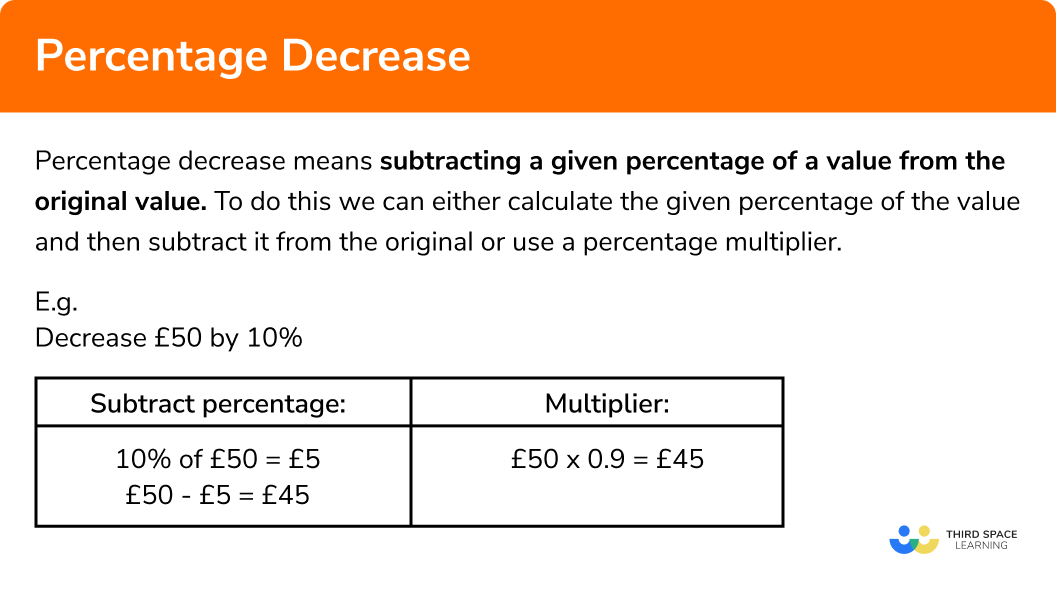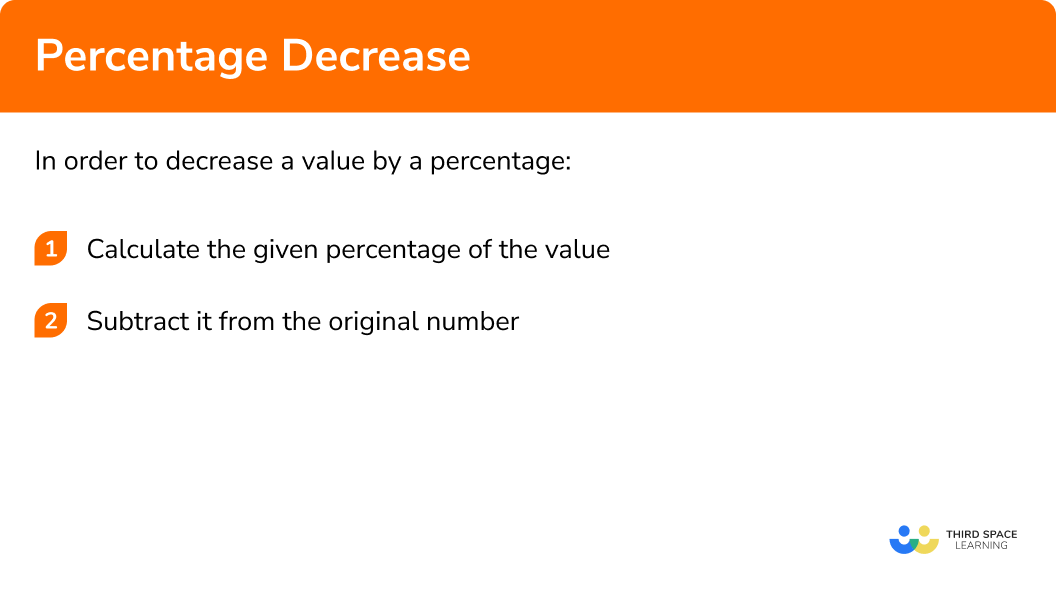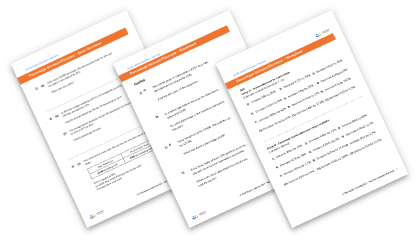GCSE Tutoring Programme
"Our chosen students improved 1.19 of a grade on average - 0.45 more than those who didn't have the tutoring."
In order to access this I need to be confident with:
Percentages of an amount Comparing between fractions, decimals and percentagesThis topic is relevant for:

Percentage Decrease
Here we will learn about percentage decrease including how to decrease a value by a given percentage, how to use multipliers to calculate percentage decrease and how to work out percentage change.
There are also percentage increase and decrease worksheets based on Edexcel, AQA and OCR exam questions, along with further guidance on where to go next if you’re still stuck.
What is percentage decrease?
Percentage decrease means subtracting a given percentage of a value from the original value. To do this we can either calculate the given percentage of the value and then subtract it from the original or use a percentage multiplier.
What is percentage decrease?

How to decrease a value by a percentage
In order to decrease a value by a percentage:
- Calculate the given percentage of the value
- Subtract it from the original number
Explain how to decrease a value by a percentage in 2 steps


Percentage increase and decrease worksheet

Get your free percentage increase and decrease worksheet of 20+ questions and answers. Includes reasoning and applied questions.
DOWNLOAD FREE
Percentage increase and decrease worksheet

Get your free percentage increase and decrease worksheet of 20+ questions and answers. Includes reasoning and applied questions.
DOWNLOAD FREEPercentage decrease examples
Example 1: non-calculator
Decrease
- Calculate
30% of£80
To do this without a calculator, the easiest way is to calculate
2 Subtract it from the initial value
Example 2: non-calculator
Decrease
Calculate 45% of 250km
Subtract it from the original value
Example 3: calculator
Decrease
Calculate 39% of 760
This time we are going to use a calculator. When using a calculator we divide the value by
Subtract it from the original value
Example 4: calculator
A jumper costing
Calculate 15% of £13.20
Subtract it from the original price
How to decrease a value by a percentage using a percentage multiplier
We can decrease a value by a percentage using a percentage multiplier. A percentage multiplier is a decimal that is related to the percentage you are trying to find.
- Subtract the percentage we are decreasing by from
100%
We subtract it from
2Convert to a decimal
3Multiply the original amount by the decimal
Example 5: using a multiplier
Decrease
Here we are calculating a 46 percent decrease so subtract 46% from 100%
Convert to a decimal. To do this we divide the percentage by 100.
Multiply the starting value by the decimal
Example 6: using a multiplier
Daniel has
This is a 27.5 percent decrease so subtract 27.5% from 100%
Convert to a decimal.
Multiply the value by the decimal
Calculating percentage decrease
Given two values, we can calculate the percentage difference. This can also be called percentage decrease or percentage loss.
We can calculate percentage change using the percentage change formula:
The same formula can be used to calculate percentage increase.
- Work out how much the value has changed by subtracting the final value from the original value
- Apply the percentage change formula
Example 7: calculating percentage change
Ricky weighed
His weight has changed from 70kg to 64.4kg. Work out the change:
Apply the percentage change formula. The change is 5.6kg and the original amount is 70kg.
Percentage decrease
Example 8: calculating percentage loss
Louise buys a car for
The value has changed from £7500 to £6150. Work out the change:
Apply the percentage change formula. The change is £1350 and the original amount is £7500.
Percentage loss
Related lessons
Percentage decrease is part of our series of lessons to support revision on percentages. You may find it helpful to start with the main percentages lesson for a summary of what to expect, or use the step by step guides below for further detail on individual topics. Other lessons in this series include:
Common misconceptions
- Converting between percentages and decimals
Incorrectly converting percentages to decimals. The most common mistakes are with single digit percentages (e.g.
Remember to divide the percentage by
E.g.
- Using an incorrect value for the denominator in the percentage decrease formula
Using the new value instead of the original value for the denominator when calculating percentage change
Practice percentage decrease questions
1. Decrease 7500m by 20\%
7480m

7520m

9000m

6000m

20\% of 7500m is 1500m .
As this is a decrease we subtract from the original amount.
7500 – 1500 = 6000
2. Decrease 44ml by 82\%
7.92ml

36.08ml

80.08ml

51.92ml

82\% of 44ml is 36.08ml .
As this is a decrease we subtract from the original amount.
44 – 36.08 = 7.92
3. Use a multiplier to decrease £754 by 23\%
£580.58

£731

£173.42

927.42

The multiplier for this decrease is 0.77 , so the correct calculation is 0.77\times754
4. Use a multiplier to decrease 254g by 38.2\%
215.8g

6.65g

97.028g

156.972g

The multiplier for this decrease is 0.618 , so the correct calculation 0.618\times254
5. Find the percentage decrease when 650kg is decreased to 320kg
330\%

50.77\%

49.23\%

203.125\%

The actual decrease is 330kg .
To calculate the percentage decrease we divide this by the original amount and multiply by 100
\frac{650-320}{650}\times100
6. Find the percentage loss when Tristan buys a tractor for £11500 and sells the tractor for £9775
17.25\%

85\%

15\%

82.25\%

The actual loss is £1725 .
To calculate the percentage loss we divide this by the original amount and multiply by 100 .
\frac{11500-9775}{11500}\times100
Percentage decrease GCSE questions
1. (a) A pair of trainers costing £35 are in a 25\% off sale. Calculate the sale price of the trainers.
(b) During the last week of the sale the trainers are reduced to £21 . Calculate the percentage decrease from the original price.
(4 marks)
(a)
25\% of £35 = £8.75
(1)
£35 – £8.75 = £26.25
(1)
(b)
£35 – £21 = £14
(1)
\frac{14}{35} \times 100=40\%
(1)
2. In 2018 a supermarket chain produced 308900 tonnes of packaging for its products. In 2019 they reduced the amount of packaging used by 4.7% .
Calculate the amount of packaging used in 2019 .
(2 marks)
4.7\% of 308900 = 14518.3
(1)
308900-14518.3 = 294381.7 tonnes
(1)
3. Samira wants to book a holiday for herself, her husband and their one child. There are two companies that she can book the holiday with. The prices of the holiday are shown below.
Travel Stars
£ 400 per adult
£ 200 per child
Ready Jet Go
£ 500 per adult
£ 100 per child
10 % discount on early bookings
Samira is going to make an early booking. With which company would she get a better deal?
You must show your working.
(5 marks)
Travel Stars: £400+£400+200 = £1000
(1)
Ready Jet Go: £500+£500+£100 = £1100
(1)
10\% of £1100 = £110
(1)
£1100-£110 = £990
(1)
Better deal with Ready Jet Go
(1)
Learning checklist
You have now learned how to:
-
Decrease a value by a given percentage
-
Use a percentage multiplier to decrease a value by a percentage
-
Calculate percent decrease between two values
The next lessons are
Still stuck?
Prepare your KS4 students for maths GCSEs success with Third Space Learning. Weekly online one to one GCSE maths revision lessons delivered by expert maths tutors.

Find out more about our GCSE maths tuition programme.